Microsoft ends support for Internet Explorer on June 16, 2022.
We recommend using one of the browsers listed below.
- Microsoft Edge(Latest version)
- Mozilla Firefox(Latest version)
- Google Chrome(Latest version)
- Apple Safari(Latest version)
Please contact your browser provider for download and installation instructions.
November 4, 2016
Experimental test of macroscopic realism problem using a superconducting flux qubit
Nippon Telegraph and Telephone Corporation (NTT) (Head Office, Chiyoda-ku, Tokyo; Hiroo Unoura, President and CEO) and the University of Illinois have performed breaking of macroscopic realism*1 in a superconducting circuit using a flux qubit*2.
The idea that an observed object exists even before it is observed is called realism. This is commonly accepted in the macroscopic world in which we live. On the other hand, in the microscopic world described by quantum mechanics*3 realism is broken*4. This means that a state cannot be determined before it is observed and is determined by the observation. If the macroscopic world is also described by quantum mechanics, realism must be broken there. The problem is can realism be broken in the macroscopic world or is there a limitation to the application of quantum mechanics in the macroscopic world? This is one of the biggest unsolved problems since the invention of quantum mechanics.
We test this using a superconducting flux qubit that has 1012 electrons flowing around it per second and show that realism is broken in this supercurrent. We demonstrate that quantum mechanics is applicable on a macroscopic scale in this supercurrent. This contributes significantly to the field of fundamental physics and shows that a superconducting flux qubit works as a real quantum device.
This work will be published in the online version of "Nature Communications" on the 4th of November, 2016 (GMT).
1.Background
Even a single electron passing through a double slit exhibits interference fringes*5. Interference fringes do not appear if the electron passes through only one slit. This means that superposition is realized between the left slit passed state and right slit passed state. This interference fringes disappear when we obtain information (by observation) revealing the slit that the electron passed through. This means that realism, as it is commonly accepted in the macroscopic world, does not hold in the microscopic world described by quantum mechanics. We can expect realism to be broken in the macroscopic world if this world also obeys quantum mechanics. The purpose of our work is to demonstrate the breaking of macroscopic realism, and thus imply that our commonly held belief is wrong (Fig. 1).
2.Achievements
NTT Basic Research Laboratories carried out a test experiment for realism breaking on a superconducting flux qubit made of aluminium (Fig. 2) and demonstrated the realism braking of a superconducting flux qubit current state by 84 times the standard deviation. This work shows that quantum mechanics can be applied on a macroscopic scale with a large supercurrent, and is not simply limited to a microscopic scale.
The experiment was performed by cooling a superconducting qubit to 10 mK. We can then prepare qubits in the lowest energy state (ground state: -1) because there is no thermal excitation in this temperature region. We then read out the qubit state after performing two operations (qubit state rotations) on the superconducting flux qubit. We compare the results obtained with and without observation during these two qubit operations.
We prepared the flux qubit in a coherent superposition of its ground (-1) and excited (+1) states with a first state operation and measured the difference between the results with and without observation (main experiment*6). If realism is true, we can expect the readout result to be independent of the observation because the state is determined before the observation. On the other hand, if realism is broken by quantum superposition, the qubit state will become +1 or -1 as a result of the observation. In our case, differences appeared in the readout results because of the observation (Fig. 3). Next, we carried out control experiments to confirm that the observation did not disturb the qubit state (control experiment*7). We prepared +1 or -1 states by using the first s3tate operation and measured the difference between the results caused by the existence of the observation. By confirming that this difference is small, we can confirm the non-invasiveness of the observation, which means that our (+1, -1) control state was not changed by the observation. The difference from the result of our main experiment is well beyond that of control experiments (Fig. 4) meaning that we have demonstrated realism breaking on macroscopic objects such as a current state (Fig. 5).
3.Technical Features
1.Measurement method suggestion mathematically equivalent to Leggett-Garg inequality*8
To confirm the realism breaking on a physical system, we need to demonstrate the breaking of the condition called the Leggett-Garg inequality. This inequality is always satisfied if realism is correct, however it can be broken in systems that do not obey realism, for instance quantum mechanics. It is difficult to show the breaking of the Leggett-Garg inequality directly because we have to measure the qubit state at least three times using high fidelity detection while the qubit maintains its quantum characteristics. These are hard conditions to achieve experimentally. We use an alternative method that is mathematically equivalent to the Leggett-Garg inequality and that avoids this detection difficulty.
2.Superconducting flux qubit and state observation
To show the breaking of macroscopic realism, we need to detect small disturbances caused by observing a macroscopic system. A superconducting flux qubit has two states corresponding to +1 and -1. Each state flows a few hundred nanoamperes clockwise and anti-clockwise superconducting circulate current, respectively. These currents correspond to 1012 electrons flowing around the loop per second, and this is a sufficiently macroscopic value to be detected with a current meter (Fig. 2). We need to observe the qubit current state without disturbing it. However, quantum non-demolition measurement*9, which can achieve this, has proved difficult to realize. We have achieved the fast and highly accurate quantum non-demolition measurement of a superconducting flux qubit current state using a Josephson bifurcation amplifier (JBA)*10 (Fig. 6).
4.Future Plans
We aim to demonstrate measurements with much less observation disturbance and to increase the macroscopic nature of the system by using a large supercurrent qubit or an ensemble of superconducting flux qubits.
Publication information
George C. Knee, Kosuke Kakuyanagi, Mao-Chuang Yeh, Yuichiro Matsuzaki, Hiraku Toida,
Hiroshi Yamaguchi, Shiro Saito, Anthony J. Leggett and William J. Munro
"A strict experimental test of macroscopic realism in a superconducting flux qubit"
Nature Communications (2016).
Glossary
- Realism
This is the idea that an object exists independent of its observation. For example "The moon exists even when no one looks at it". - Superconducting flux qubit
This is a superconducting circuit constructed from a superconducting loop including Josephson junctions. By applying a magnetic field with an optimal bias, we can consider this circuit to be a quantum two level system, with clockwise and anti-clockwise current states. - Quantum mechanics
These are a set of physical laws that can govern the behavior of particles and waves at the microscopic level (for example in electrons and atoms). It allows strange behaviour such as quantum superposition and entanglement. - Realism breaking
This is the idea that the state is determined at (not before) the time of the observation. For example, with a quantum superposition of two states, the state is not determined before its observation. The observation collapses one of the two states that make up the superposition. - Interference fringes
This is a stripe pattern appearing when a system composed of several superposed waves is measured. - Main experiment
This is an experiment designed to confirm that the generated superposition state changes into one of +1 or -1 states by observation. It is expected that the results obtained with and without observation show different values, respectively, if a quantum superposition state is realized. - Control experiments
These are experiments undertaken to confirm that the state is not changed by observation when we prepare a pure +1 or -1 state. We expect to see sufficient small observation induced changes in these experiments to distinguish changes in the superposition state. - Leggett-Garg inequality
This is an inequality obtained by correlating values measured at several different times. This inequality is satisfied in a system in which realism appears, however this is sometimes broken in the quantum world. - Quantum non-demolition measurement
This is a measurement that keeps the state after measurement unchanged when we prepare an eigenstate such as an excited state or a ground state. - Josephson bifurcation amplifier (JBA)
This is a method detecting for small displacements. We can generate a bistable state in a nonlinear resonator including a Josephson junction by driving it with an optimal microwave. The nonlinear resonator converges to a different stable state depending on the displacement of the coupled object, so we can obtain information about displacement. We can readout a superconducting flux qubit state quantum non-destructively.
Fig. 1 Breaking of macroscopic realism
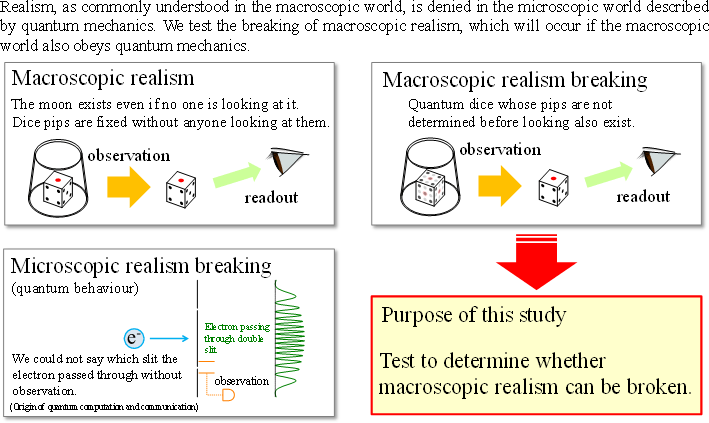
Fig. 2 Superconducting flux qubit
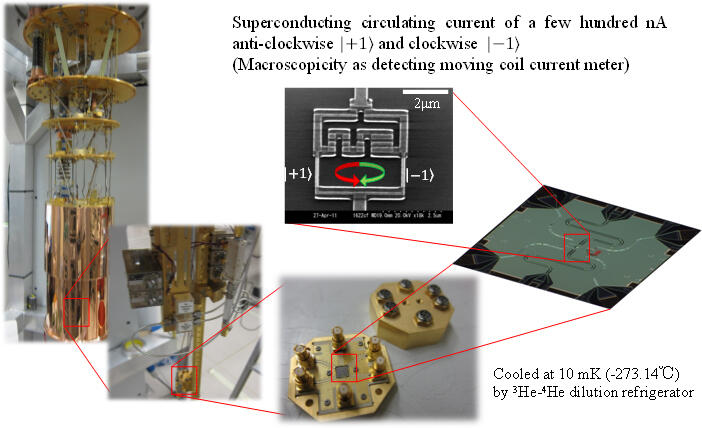
Fig. 3 Measurement method
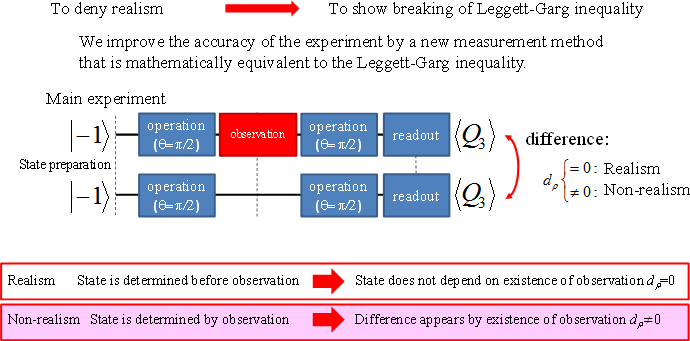
Fig. 4 Experimental result and accuracy

Fig. 5 Realism breaking on a current state
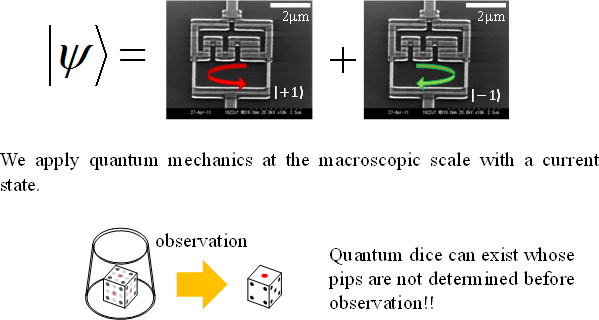
Fig. 6 State observation of a superconducting flux qubit
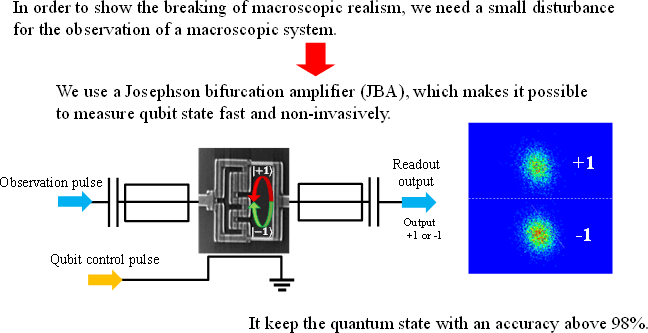
Contact information
Nippon Telegraph and Telephone Corporation
Science and Core Technology Laboratory Group, Public Relations
a-info@lab.ntt.co.jp
Information is current as of the date of issue of the individual press release.
Please be advised that information may be outdated after that point.
NTT STORY
WEB media that thinks about the future with NTT











